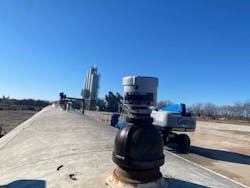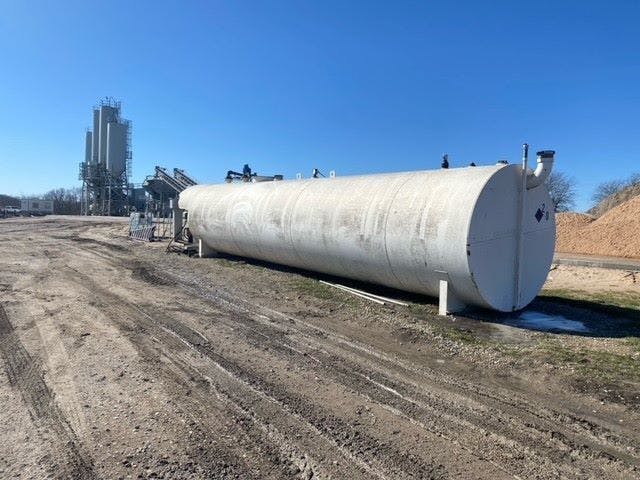Continual technological advancements of radar sensors enables them to be economically feasible in more applications. Because of this evolution, millions of radar sensors are in use today in industrial applications.
Traditionally, applications that utilize radar measurement focus on process monitoring and control in-plant. In these applications, wiring to a control system or power supply is required and expected. However, there are other applications for radar sensors that extend beyond the plant confines, and could have a major impact on efficiency and profitability of business if only the burden of wiring was removed. One of these applications is in the area of logistics.
To find out more about radar in logistics applications, Control talked with Shaun Pogue, IIoT Manager for VEGA Americas Inc.
Q: How can radar sensors help industry achieve efficient logistics?
A: Efficient logistics will always be a goal if businesses receive or ship product. Over the last decade, businesses have become more sensitive to logistics costs and inefficiencies due to a variety of evolving market influences. Companies unable to keep pace with the changing landscape can face stifled growth.
An easy way to eliminate inefficiency is better visualization of on-hand material and capacity to store additional material. Many companies use ineffective methods, including manual measurement, calculated measurements based on ticketing systems, or unreliable sensor technologies. Radar overcomes these issues. It eliminates the need for measurement by hand, measures position of actual material in the vessel within a fraction of an inch, is unaffected by storage conditions, and requires no maintenance.
Q: How have advances in radar technology addressed “stranded” measurements?
A: Technological advancements like utilizing loop power, creating more compact antenna systems, and using higher frequencies and dynamic output, enable radar to measure materials that couldn’t be measured in the past with a higher degree of reliability and ease of installation. Unfortunately, they require connected wires for power and/or communication, leading to many desired applications still being left “stranded”. For example, a chemical tank in the field may lack line power or communication to a central information system.
Due to security and safety concerns, radar measurements on the plant floor are generally isolated from the rest of the organization, so the information is not accessible to other parts of the organization that may find it valuable. For example, a tank level measurement connected to a control system on the plant floor is not readily available to a buyer in an office who is responsible for scheduling the next delivery. In many situations, the desired inventory information resides at another company, adding another barrier to obtaining the information.
VEGA introduced a radar sensor that bridges the gap between a business and stranded measurements. The VEGAPULS Air is an “autarkic” radar sensor, meaning it is independent and self-sufficient, contains its own power supply, and communicates inventory information wirelessly and securely to the cloud. It allows businesses to obtain inventory information where not previously possible due to wiring or security concerns.
Q: What role can the Industrial Internet of Things (IIoT) play to ensure quality information when it comes to radar technology?
A: Businesses require trustworthy information to make smart, strategic decisions. This is also true in logistics, where planners and dispatchers base decisions on the the inventory needs of remote tanks. For example, delaying a delivery of material until a larger, more optimal load size can fit results in fewer deliveries but exposes one to greater risk of running out. However, this risk can be mitigated if the quality of the information upon which the decision is made is improved.
Simply measuring inventory information is not enough. It is equally important that it be timely, accurate and accessible. For these reasons, one should consider radar devices with built-in telemetry that communicate inventory data to a cloud portal, where anyone with authorized access can view all the remote tanks in a consolidated view. Also, consider that the radar not only transmits the measurement, but also its sensor health, measurement time stamp, and battery life. In addition, once data is stored in the cloud, it can be easily and securly shared with other applications, such as demand planning systems via an application programming interface (API).
The quality of the information enables decision makers to execute smarter, more strategic decisions. IIoT is uniquely suited to provide quality inventory information that can be used in the digitalization of logistics processes.
Q: What are the keys to ensure security of radar devices?
A: Recognizing that security is a necessary component in a robust inventory visualization platform is an important first step. The data will necessarily include information that is propietary to your business and which you will want to ensure is only used for its intended purposes.
For this reason, security concerns should not just be limited to the radar measurement, but also include telemetry and data storage components. For example VEGA’s solution uses end-to-end encryption for data transmission from the radar device to the application software, and our hosting service complies with ISO 27001 and is SOC 2 certified to ensure our customer’s data is protected
Q: Most corporations have sustainability initiatives but struggle to find tangible ways to achieve them. How does smart logistics using radar help the cause?
A: Studies show that sustainability initiatives are more likely to be successful when they also solve parallel business issues. If you consider that roughly 25% of the world’s greenhouse gases (GHG) are related to transportation and roughly 25% of that comes from trucks, you can understand that improving their utilization and efficiency directly reduces GHG emissions.
If we consider logistics with the fewest trucks and drivers, it helps solve business issues related to the driver shortage, while also reducing GHG emissions.



